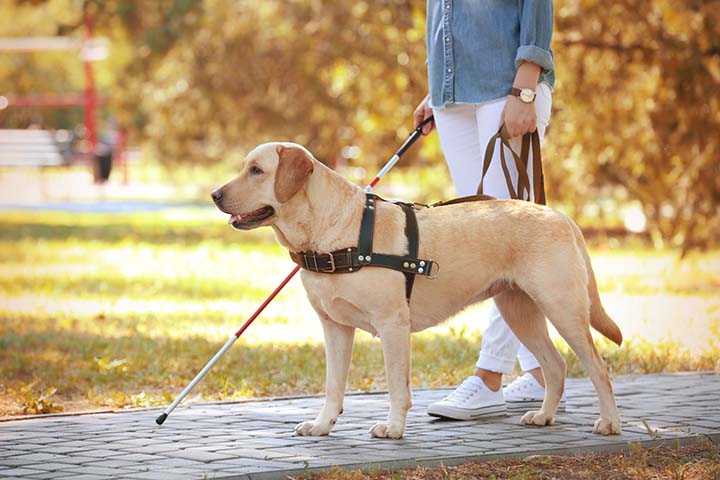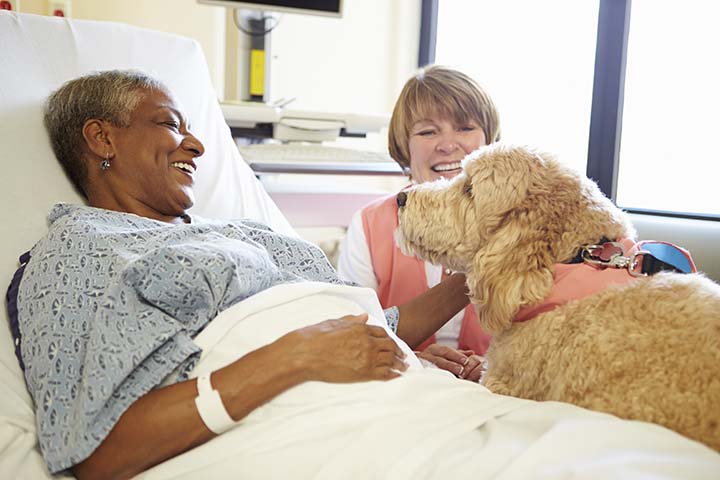16 Oct 2020
Benefits of Pet Therapy in Cancer Patients
Estimated read time: 5 minutes, 58 seconds
People who own pets, especially dogs, know how beneficial they can be to our mental health. They cheer you up, are great company, are loyal and grateful, and give back much more love than they receive. What not everyone knows is that pets are being used more and more frequently to treat illnesses such as cancer. Science has proven that pets can be genuinely therapeutic.
Using pets in a variety of medical and psychological procedures is nothing new. In 1969, Boris M. Levinson had published his book, “Pet-Oriented Child Psychotherapy.” This pioneering work set the foundations for understanding how animals can help to improve humans’ mental and physical well-being. Levinson describes how using dogs in psychological treatment was vital in the therapy being successful.
Since then, science has continued to explore the role of animals in therapies. The idea quickly spread from psychology to other areas of medicine, and it is now considered commonplace to use dogs and other pets in treating a variety of illnesses.
It is so common that medical professionals using these techniques have formed the International Association of Human-Animal Interaction Organization, or IAHAIO. The institution follows the advances made through animal-assisted therapy and animal training in psychology, education, service dogs, coaching, and one of the most exciting areas—what is known as animal-assisted therapy for physical ailments. The IAHAIO defines this as a “planned and structured therapeutic intervention directed and delivered by health professionals.” The IAHAIO also notes that these sessions should be directed by formally trained professionals with the corresponding degrees in the proper settings.
In addition, these professionals should be able to care for the needs, health, and stress level of the animals participating.
The goal is for professionals to include the animals as an integral part of the treatment process to promote physical, social, emotional and cognitive improvement in patients.
In general, therapies consist of allowing patients to spend time with the animals, engage with them, care for them, walk them, or just pet them. This close contact with animals provides the beneficial results studied in zootherapy. Many different types of animals can be used in medical care, but the most common are dogs.

They have coexisted with humans for thousands of years and are loyal and selfless companions. Of course, the most docile and affectionate breeds are used, so that there are never any risks of any kind for the individuals interacting with the dogs.
Why use animals to cure people?
When professionals are asked why animals positively affect patients, specialists have a clear answer: animals give people love and attention and expect nothing in return. They are always loyal, affectionate, and friendly. These are the ideal qualities for individuals suffering from significant insecurities or vulnerabilities, or are going through situations that affect their emotions or that are harmful to their physical and mental health.
Animals help to motivate people and improve self-confidence and self-esteem. They reduce fear, increase emotional bonds, and without a doubt, give people a feeling of security.
This ability to reduce stress is why animals help improve doctors’ interventions and therapies, eliminate resistance, and encourage patients to face their treatments with a better mood and strength. It has been proven that the company of animals helps people with anxiety to breathe more calmly,
as they contribute to producing hormones that improve mood and help to reduce physical pain, especially chronic pain.
The relationship between heart health and depression is well documented. There is growing evidence that there is a strong link between anxiety and heart disease. Specifically, individuals with generalized anxiety disorder seem to suffer higher rates of heart attacks and other heart problems.
This exciting and valuable work carried out in pet therapy can be applied to a wide range of illnesses and health problems, especially psychological disorders such as depression and anxiety, loneliness, difficulty concentrating, lack of empathy, among others.


They can also be used as a treatment to help mitigate symptoms of Alzheimer’s, dementia, bipolar disorder, post-traumatic stress syndrome, hyperactivity, Down’s syndrome, and more.
There are animals, such as horses, which are used to cure physical pathologies. They can be used in physical therapy for people with mobility issues or bone and muscle problems. For these people, horseback riding and other exercises can contribute to a notable improvement in their symptoms. Disorders affecting balance can also be treated with pet therapy. Patients and pets work together to restore lost senses as animals are very good at improving fine motor skills. They also help their owners to carry out everyday tasks, such as getting out of bed, which can sometimes be difficult for patients.
One of the most interesting applications is the role of pets in cancer treatments. In recent years they have been used successfully in many cancer treatments, and there is a growing consensus among scientists regarding the benefits of animals in alleviating and healing these types of illnesses.
Dogs and cancer
In general, therapies used to treat cancer produce high levels of stress and result in weakness. Alleviating the effects of radiation and chemotherapy treatments has been one of the doctors’ goals of using them since these treatments were first used.
A study carried out at Mount Sinai Beth Israel Hospital found that in 2015 patients with gastro-intestinal, head, and neck cancer saw notable improvements in their quality of life upon receiving visits from a dog while suffering the effects of treatments. Even when they were under the worst effects of radiation and chemotherapy, interaction with the dogs produced notable improvements in their mood and ability to recover.
Several scientific works proved that dogs have contributed to reducing stress and depression by up to 50% in those undergoing chemotherapy.

Dogs not only help to alleviate symptoms of a tumor and assist patients in their treatment, but they can also be trained to detect some types of cancer.
Can dogs smell cancer?
Some researchers say that dogs can detect cancer in humans. Like many other diseases, cancer leaves specific indicators and odors, in a persons’ body and bodily fluids. Cancer cells, or healthy cells affected by cancer, produce and release these “odor signatures.”
Dogs are trained to sniff out explosives and narcotics due to their strong sense of smell, which is 10,000 times more potent than a humans’. Their powerful noses can detect viruses, bacteria and signs of cancer in a persons’ body or bodily fluids.
They can detect some substances at a very low concentration, which makes their noses sensitive enough to sniff out cancer markers in peoples’ breath, urine and blood. For example, they can identify kidney cancer just by smelling a blood sample. Some studies show that they are able to correctly identify cancer 97% of the time.
These “medical” dogs are used more frequently in the early detection of certain types of cancers such as kidney, prostate, colon or rectal, ovarian or melanoma. However, the effectiveness and reliability of canine olfactory cancer detection does require additional study.
What we do know without a doubt is that the unconditional love of animals plays a crucial role in the treatment of many illnesses. Dogs, cats, horses, dolphins and other living things help humans to be stronger, more resistant, and quickly recover from illnesses as serious and destructive as cancer.
Source: PsiAra: Desarrollo de la inteligencia emocional en niños a través de la terapia asistida por animales, International Association of Human-Animal Interaction Organizations (IAHAIO): “Effects of a Form of Equine-Facilitated Learning on Heart Rate Variability, Immune Function, and Self-Esteem in Older Adults”, MDEdge: “Beneficial effects of animal-assisted visits on quality of life during multimodal radiation-chemotherapy regimens”, Frontiers in Veterinary Science: “When the Nose Doesn’t Know: Canine Olfactory Function Associated With Health, Management, and Potential Links to Microbiota”,National Center for Biotechnology Information: “Pet therapy effects on oncological day hospital patients undergoing chemotherapy treatment.”, PBS: “Dogs' Dazzling Sense of Smell”


